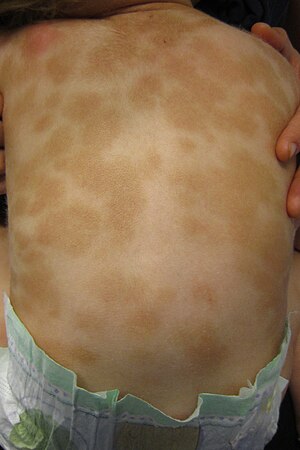Urticaria pigmentosa
| Urticaria pigmentosa | |
|---|---|
 |
|
| The back of a child with uriticaria pigmentosa | |
| Classification and external resources | |
| Specialty | medical genetics |
| ICD-10 | Q82.2 |
| ICD-9-CM | 757.33 |
| DiseasesDB | 7864 |
| MedlinePlus | 001466 |
| MeSH | D014582 |
Urticaria pigmentosa (also known as "Generalized eruption of cutaneous mastocytosis (childhood type)" ) is the most common form of cutaneous . It is a rare disease caused by excessive numbers of mast cells in the skin that produce hives or lesions on the skin when irritated.
Urticaria pigmentosa is characterized by excessive amounts of mast cells in the skin. Red or brown spots are often seen on the skin, typically around the chest and forehead. These mast cells, when irritated (e.g. by rubbing the skin, heat exposure), produce too much histamine, triggering an allergic reaction that leads to hives localized to the area of irritation, sometimes referred to as Darier's sign. Severe itching usually follows, and scratching the area only serves to further symptoms. Symptoms can be mild (flushing and hives that require no treatment), moderate (diarrhea, tachycardia, nausea/vomiting, headache, and fainting), or life-threatening (vascular collapse requiring emergency treatment and hospitalization).
The majority of urticaria pigmentosa cases are caused by a point mutation at amino acid 816 of the proto-oncogene c-kit. c-kit is a transmembrane protein which, when bound to Mast Cell Growth Factor (MCGF), signals the cell to divide. Mutations in position 816 of c-kit can result in a constant division signal being sent to the mast cells, resulting in abnormal proliferation. Different mutations have been linked to different onset times of the disease. For example, the Asp816Phe and Asp816Val mutations (the aspartate normally at position 816 in the c-kit protein has been replaced with phenylalanine or valine respectively) have been associated with early manifestation of the disease (mean age of onset: 1.3 and 5.9 months respectively). The c-kit gene is encoded on the q12 locus of chromosome 4.
Several factors can worsen the symptoms of urticaria pigmentosa:
The classification of NSAIDs can be disputed. Aspirin, for example, causes the mast cells to degranulate, releasing histamines and causing symptoms to flare. However, daily intake of 81 mg aspirin may keep the mast cells degranulated. Thus, while symptoms may be worsened at first, they can get better as the mast cells are unable to recharge with histamine.
...
Wikipedia
